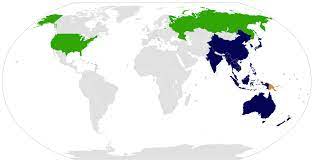
Table of Contents
History and Background
The East Asia Summit was initiated in 2005 by the leaders of the ASEAN countries (Association of Southeast Asian Nations). The first summit was held in Kuala Lumpur, Malaysia, and was attended by 16 countries, including China, Japan, South Korea, India, Australia, and New Zealand. The EAS was established as a platform to promote cooperation in the region and address common challenges such as terrorism, climate change, and economic integration.
Structure and Objectives
The East Asia Summit is structured as a leaders-led forum, which means that the leaders of member countries attend the summit and discuss issues of common concern. The summit is held annually and is chaired by the host country. The objectives of the EAS are to promote regional peace, security, and stability, and to enhance economic cooperation and integration.
Member Countries
The East Asia Summit (EAS) has 18 member countries, which are:
- Australia
- Brunei Darussalam
- Cambodia
- China
- India
- Indonesia
- Japan
- Laos
- Malaysia
- Myanmar
- New Zealand
- Philippines
- Russia
- Singapore
- South Korea
- Thailand
- United States
- Vietnam
Achievements
Over the years, the East Asia Summit has achieved several significant milestones. One of the most notable achievements is the establishment of the ASEAN Economic Community (AEC) in 2015, which aims to create a single market and production base in Southeast Asia. The EAS has also played a key role in addressing the threat of terrorism in the region and promoting regional cooperation in disaster management.
Issues and Challenges
Despite its achievements, the East Asia Summit faces several challenges. One of the main challenges is the increasing tensions between China and other countries in the region, particularly over territorial disputes in the South China Sea. Another challenge is the growing threat of North Korea’s nuclear program, which poses a significant threat to regional security. In addition, the EAS has been criticized for its slow progress in promoting economic integration and addressing environmental issues.
Future Prospects
The future of the East Asia Summit is closely linked to the future of the region. As the region continues to grow in importance, the EAS is likely to become an increasingly important forum for regional cooperation and integration. However, the success of the EAS will depend on its ability to address the challenges facing the region, particularly those related to security and economic integration. To remain relevant, the EAS must also adapt to changing geopolitical and economic realities.
Conclusion
The East Asia Summit is an important forum for regional cooperation and integration. Its achievements over the years demonstrate the value of regional cooperation in addressing common challenges. However, the EAS faces several challenges, particularly those related to security and economic integration. To remain relevant, the EAS must adapt to changing geopolitical and economic realities and continue to promote cooperation among its member countries.